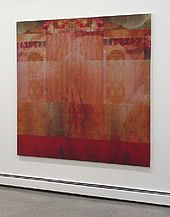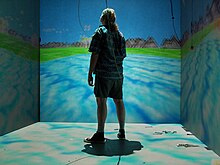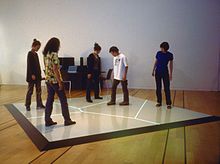Jyllhedgehog367 Mar 2 2018 Hobbyist Digital Artist No Problem! Your Art Is Incredible ðå¸â€˜â

Irrational Geometrics digital fine art installation 2008 by Pascal Dombis

Joseph Nechvatal birth Of the viractual 2001 computer-robotic assisted acrylic on canvas

Digital fine art is an creative work or practice that uses digital technology as role of the creative or presentation process. Since the 1960s, various names accept been used to describe the process, including computer art and multimedia art.[1] Digital art is itself placed under the larger umbrella term new media fine art.[2] [3]
Later some initial resistance,[4] the impact of digital engineering science has transformed activities such as painting, literature, cartoon, sculpture and music/sound art, while new forms, such as net fine art, digital installation fine art, and virtual reality, have become recognized artistic practices.[five] More generally the term digital artist is used to draw an artist who makes use of digital technologies in the production of art. In an expanded sense, "digital art" is gimmicky art that uses the methods of mass product or digital media.[half-dozen]

The techniques of digital art are used extensively by the mainstream media in advertisements, and by film-makers to produce visual effects. Desktop publishing has had a huge bear on on the publishing earth, although that is more related to graphic blueprint. Both digital and traditional artists use many sources of electronic information and programs to create their piece of work.[7] Given the parallels between visual and musical arts, it is possible that general acceptance of the value of digital visual art volition progress in much the same way as the increased acceptance of electronically produced music over the final three decades.[8]
Digital art tin can be purely reckoner-generated (such as fractals and algorithmic art) or taken from other sources, such equally a scanned photograph or an image drawn using vector graphics software using a mouse or graphics tablet.[ix] Though technically the term may be applied to art done using other media or processes and merely scanned in (from scanography ), it is usually reserved for art that has been non-trivially modified by a computing process (such as a computer program, microcontroller or any electronic system capable of interpreting an input to create an output); digitized text data and raw sound and video recordings are not unremarkably considered digital art in themselves, but can exist function of the larger project of calculator art and information fine art.[10] Artworks are considered digital painting when created in a similar manner to non-digital paintings but using software on a computer platform and digitally outputting the resulting image as painted on canvas.[eleven]
Andy Warhol created digital art using a Commodore Amiga where the computer was publicly introduced at the Lincoln Center, New York in July 1985. An image of Debbie Harry was captured in monochrome from a video camera and digitized into a graphics program called ProPaint. Warhol manipulated the epitome adding colour by using flood fills.[12] [13]
Amongst varied opinions on the pros and cons of digital technology on the arts, at that place seems to exist a stiff consensus within the digital art community that it has created a "vast expansion of the creative sphere", i.east., that it has greatly broadened the creative opportunities available to professional and non-professional artists alike.[14]
Whilst 2nd and 3D digital art is beneficial as it allows preservation of history that would otherwise have been destroyed by events like natural disasters and state of war, in that location is the outcome of who should own these 3D scans - i.due east. who should own the digital copyrights.[xv]
Computer-generated visual media [edit]

Digital visual fine art consists of either second visual information displayed on an electronic visual brandish or data mathematically translated into 3D data, viewed through perspective projection on an electronic visual display. The simplest is 2D computer graphics which reflect how yous might draw using a pencil and a piece of paper. In this case, however, the image is on the computer screen and the instrument yous draw with might be a tablet stylus or a mouse. What is generated on your screen might appear to be drawn with a pencil, pen or paintbrush. The 2d kind is 3D computer graphics, where the screen becomes a window into a virtual environs, where y'all arrange objects to be "photographed" by the figurer. Typically a 2D reckoner graphics utilise raster graphics as their chief means of source data representations, whereas 3D reckoner graphics use vector graphics in the creation of immersive virtual reality installations. A possible tertiary paradigm is to generate art in second or 3D entirely through the execution of algorithms coded into computer programs. This can be considered the native art class of the reckoner, and an introduction to the history of which is available in an interview with calculator art pioneer Frieder Nake.[16] Fractal art, Datamoshing, algorithmic art and existent-time generative art are examples.
Reckoner generated 3D still imagery [edit]
3D graphics are created via the process of designing imagery from geometric shapes, polygons or NURBS curves[17] to create three-dimensional objects and scenes for utilise in various media such equally moving picture, television, impress, rapid prototyping, games/simulations and special visual furnishings.
At that place are many software programs for doing this. The technology can enable collaboration, lending itself to sharing and augmenting past a artistic attempt like to the open source movement, and the artistic commons in which users can collaborate in a project to create art.[xviii]
Pop surrealist creative person Ray Caesar works in Maya (a 3D modeling software used for digital animation), using it to create his figures as well equally the virtual realms in which they exist.
Reckoner generated animated imagery [edit]
Computer-generated animations are animations created with a computer, from digital models created by the 3D artists or procedurally generated. The term is normally applied to works created entirely with a computer. Movies brand heavy apply of computer-generated graphics; they are called computer-generated imagery (CGI) in the pic industry. In the 1990s, and early 2000s CGI advanced enough so that for the first time information technology was possible to create realistic 3D computer animation, although films had been using extensive calculator images since the mid-70s. A number of mod films have been noted for their heavy use of photo realistic CGI.[19]
Digital installation art [edit]

Digital installation art constitutes a broad field of action and incorporates many forms. Some resemble video installations, especially large scale works involving projections and live video capture. Past using projection techniques that heighten an audience's impression of sensory envelopment, many digital installations attempt to create immersive environments. Others become even farther and attempt to facilitate a complete immersion in virtual realms. This type of installation is generally site-specific, scalable, and without fixed dimensionality, meaning it can be reconfigured to accommodate dissimilar presentation spaces.[21]
Noah Wardrip-Fruin'south "Screen" (2003) is an instance of interactive digital installation art which makes use of a Cave Automated Virtual Surroundings to create an interactive experience.[22] Scott Snibbe's "Boundary Functions" is an example of augmented reality digital installation art, which responds to people who enter the installation by drawing lines between people indicating their personal space.[20]
Digital art and blockchain [edit]
Blockchain, and more specifically NFTs, take been associated with Digital Art since the NFTs craze of 2020 and 2021. While the technology received many critics and has many flaws related to plagiarism and fraud (due to its almost completely unregulated nature),[23] auction houses like Sotheby's, Christie'due south and various museums and galleries in the earth started collaborations and partnerships with digital artists, selling NFTs associated with digital artworks (via NFT platforms) and showcasing those artworks (associated to the corresponding NFTs) both in virtual galleries and real life screens, monitors and TVs.[24] [25]
Art theorists and historians [edit]
Notable art theorists and historians in this field include Oliver Grau, Jon Ippolito, Christiane Paul, Frank Popper, Jasia Reichardt, Mario Costa, Christine Buci-Glucksmann, Dominique Moulon, Robert C. Morgan, Roy Ascott, Catherine Perret, Margot Lovejoy, Edmond Couchot, Fred Forest and Edward A. Shanken.
Subtypes [edit]
- Art game
- ASCII art
- Chip art
- Computer art scene
- Computer music
- Crypto art
- Cyberarts
- Digital illustration
- Digital imaging
- Digital literature
- Digital painting
- Digital photography
- Digital poetry
- Digital sculpture
- Digital architecture
- Dynamic Painting
- Electronic music
- Evolutionary art
- Fractal art
- Generative art
- Generative music
- GIF art
- Immersion (virtual reality)
- Interactive fine art
- Internet art
- Motion graphics
- Music visualization
- Photograph manipulation
- Pixel fine art
- Return art
- Software fine art
- Systems art
- Textures
- Tradigital fine art
Related organizations and conferences [edit]
- Artfutura
- Artmedia
- Austin Museum of Digital Art
- Computer Arts Society
- EVA Conferences
- Los Angeles Center for Digital Fine art
- Lumen Prize
- onedotzero
- V&A Digital Futures
Run across also [edit]
- Algorithmic art
- Reckoner fine art
- Figurer graphics
- Electronic art
- Generative art
- Graphic arts
- New media art
- Theatre of Digital Art
- Virtual art
References [edit]
- ^ Reichardt, Jasia (1974). "Twenty years of symbiosis between art and science". Art and Science. XXIV, (1): 41–53.
- ^ Christiane Paul (2006). Digital Art, pp. 7–8. Thames & Hudson.
- ^ Lieser, Wolf. Digital Art. Langenscheidt: h.f. ullmann. 2009, pp. 13–xv
- ^ Taylor, Chiliad. D. (2012). The soulless usurper: Reception and criticism of early computer art. In H. Higgins, & D. Kahn (Eds.), Mainframe experimentalism: Early on digital computing in the experimental arts. Berkeley, CA: Academy of California Printing
- ^ Donald Kuspit The Matrix of Sensations VI: Digital Artists and the New Creative Renaissance
- ^ Charlie Gere Art, Time and Applied science: Histories of the Disappearing Torso (Berg, 2005). ISBN 978-1-84520-135-7 This text concerns artistic and theoretical responses to the increasing speed of technological development and operation, especially in terms of so-called 'existent-time' digital technologies. It draws on the ideas of Jacques Derrida, Bernard Stiegler, Jean-François Lyotard and André Leroi-Gourhan, and looks at the work of Samuel Morse, Vincent van Gogh and Malevich, amongst others.
- ^ Frank Popper, Art of the Electronic Historic period, Thames & Hudson, 1997.
- ^ Charlie Gere, (2002) Digital Civilization, Reaktion.
- ^ Christiane Paul (2006). Digital Art, pp. 27–67. Thames & Hudson.
- ^ Wands, Bruce (2006). Fine art of the Digital Age, pp. 10–xi. Thames & Hudson.
- ^ Paul, Christiane (2006). Digital Art, pp. 54–60. Thames & Hudson.
- ^ 'Reimer, Jeremy (October 21, 2007). "A history of the Amiga, part 4: Enter Commodore". Arstechnica.com . Retrieved June 10, 2011.
- ^ YouTube. Archived from the original on 2009-05-07.
- ^ Bessette, Juliette, Frederic Fol Leymarie, and Glenn W. Smith (16 September 2019). "Trends and Anti-Trends in Techno-Fine art Scholarship: The Legacy of the Arts "Machine" Special Issues". Arts. 8 (iii): 120. doi:10.3390/arts8030120.
{{cite periodical}}: CS1 maint: uses authors parameter (link) - ^ Sydell, Laura (21 May 2018). "3D Scans Help Preserve History, Just Who Should Own Them? 2018". NPR. Archived from the original on 2022-01-18. Retrieved vii Feb 2021.
- ^ Smith, Glenn (31 May 2019). "An Interview with Frieder Nake". Arts. viii (two): 69. doi:ten.3390/arts8020069.
- ^ Wands, Bruce (2006). Fine art of the Digital Age, pp. 15–16. Thames & Hudson.
- ^ Foundation, Blender. "Virtually". blender.org . Retrieved 2021-02-25 .
- ^ Lev Manovich (2001) The Linguistic communication of New Media Cambridge, Massachusetts: The MIT Printing.
- ^ a b "Boundary Functions"
- ^ Paul, Christiane (2006). Digital Art, pp 71. Thames & Hudson.
- ^ "screen - noah wardrip-fruin".
- ^ "Does NFT Fine art Take A Place In The Museum In 2022?". jingculturecommerce.com.
- ^ "Natively Digital: A Curated NFT Sale". sothebys.com.
- ^ "Beeple sold an NFT for $69 million". theverge.com.
External links [edit]
-
 Media related to Digital fine art at Wikimedia Commons
Media related to Digital fine art at Wikimedia Commons - Dreher, Thomas. "History of Calculator Fine art"
- Zorich, Diane M. "Transitioning to a Digital World"
Source: https://en.wikipedia.org/wiki/Digital_art
0 Response to "Jyllhedgehog367 Mar 2 2018 Hobbyist Digital Artist No Problem! Your Art Is Incredible ðå¸â€˜â"
Enviar um comentário